How to Harmonize the Major and Minor Scale. In addition to knowing the harmonization of the Harmonic and Melodic Minor Scale. Know which CHORDS to use for each degree of each music scale.
I will begin by defining what the HARMONIZATION of Musical Scales consists of. The harmonization of a musical scale consists of knowing the types of chords that are harmonized with a given scale. For these chords to be harmonized, all the notes that make up the chord must also be in the scale that we want to harmonize.
The Harmonization of Musical Scales consists of knowing what type of chord fits in each degree, of each specific scale.
In short, each chord should adapt to the notes that make up the scale or key in question. Consequently, some chords would fit in major (M), others in minor (m), or would be diminished (dim) or augmented (aug). Although the crux of the matter is simply knowing which chords fit in major, and which fit in minor.
This will save us a lot of work when composing a musical theme, and also a lot of time when creating the chords for a song, once the key of the song is known. Although this would not be a mathematical method, since it is very common to find songs with one or some chords with notes that are outside the primary key.
Well, in this article you will learn about the HARMONIZATION of the most used Musical Scales, such as the Major and Minor Scales. But I will also show you the harmonization of more complex scales such as the Harmonic and Melodic Minor Scales.
How to Harmonize the Major Scale
So we start with one of the most used scales: the major scale. The chords for the major scale would be established in a general way, as follows:
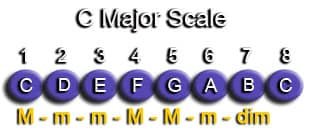
If we place, for example, the C major scale on the yellow diagram, we would obtain the basic chords that we must use within this scale. Most of the time this is enough to play any piece of music that is in this specific key.
If we need to play in another key, such as the key of D major, there is no problem. We plant the D major scale on this same pattern and that’s it.
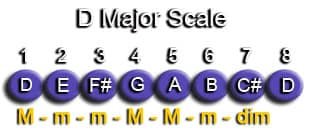
If you want to know all the notes of all the keys, both in major and minor, you can look at the page “Notes of the Major and Minor Scale“.
How to Harmonize the Minor Scale
To harmonize the natural minor scale we would use this same distribution. Since the structure of both scales are similar, but the arrangement of the chords begins from the 6th note of the major scale. Since the natural minor scale flows from the 6th or relative minor note, of any major scale. Composed of exactly the same notes as its relative Major.
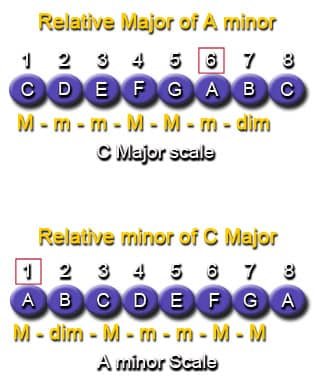
These scales would be two musical modes. The major scale would be the Ionian mode, and the minor scale would be the Aeolian mode. We can use this same pattern for the rest of modes.
For example, for the Mixolydian mode we would have to use the same major scale pattern, but starting from the 5th note of a major scale. Since this musical mode flows from the fifth degree of the major scale. For this reason the Mixolydian mode is a Major mode.
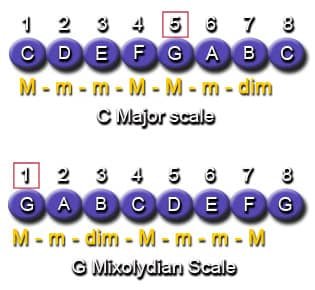
How to Harmonize the Harmonic minor Scale
The major scale has a greater tonal response than the minor scale. This means that the resolution, finality and stability of its tonic note is felt more clearly and more strongly.
To improve the tonal response of a minor scale, the 7th note was raised a semitone, opening an interval of a tone and a half between the sixth and seventh degree.
In this way, a more resolving tonic is obtained, and the tonal response is increased, by bringing the 7th note closer to its tonic. Thus it will be separated from it only by a semitone, as would happen with the 7th note of the major scale, giving birth to the harmonic minor scale.

This is a basic scale in genres such as Neoclassical Metal, since it provides that touch of flavor to classical music, but also used as a resource in other musical genres.
So far everything is correct. But by altering the intervals after raising the 7th note of the minor scale a semitone, to obtain a harmonic minor scale, we would consequently have to modify all the chords that had the old note one semitone lower. Consequently, we would have to harmonize the scale again, remaining as follows.
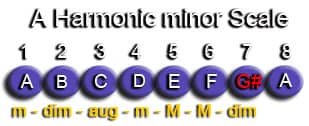
In this case we would have to use an augmented chord for the third degree, a major chord for the fifth degree, and a diminished chord for the seventh degree. These would be the three degrees that we should modify regarding the harmonization of the natural minor scale.
HARMONIZATION of the Melodic minor Scale
The harmonic minor scale was very useful from the point of view of harmony. But when a tone and a half space opened between the 6th and 7th notes, its melodic qualities were diminished.
To solve this, the 6th note of the harmonic minor scale was raised one semitone. The distribution of the last four intervals of the new scale resembles the major scale. Consequently, we obtain a Mixed Scale with half similar to the minor scale, and the other half similar to the major scale. The Melodic Minor Scale or Jazz Minor Scale was born, due to its wide use within this genre. Although it is equally used in the vast majority of styles.
Therefore, the harmonization of this musical scale would be as follows:

If we compare this scale with the major scale, its only difference would be that the 3rd note is a semitone lower. That is, by simply lowering the 3rd note of a major scale a semitone, we would already have a melodic minor scale in the same key. An even simpler learning method.
For example, if we take the C Major scale, and we want to play in the melodic C minor scale, we would only have to lower the 3rd note of the major scale a semitone, and we would have it (image above).
